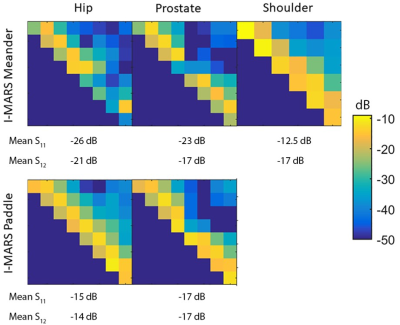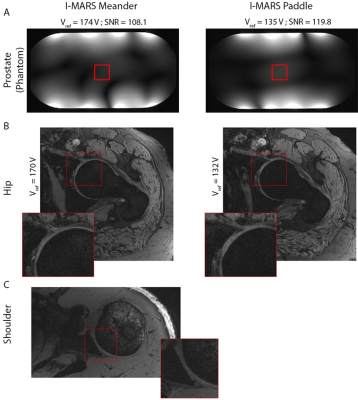0135
A novel type of radiofrequency antenna for multi-regional 7T MRI1School of Information Technology and Electrical Engineering, The University of Queensland, Brisbane, Australia, 2Siemens Healthcare Pty Ltd, Brisbane, Australia, 3School of Human Movement and Nutrition Sciences, The University of Queensland, Brisbane, Australia
Synopsis
A novel radiofrequency coil element, named integrated multi-modal antenna with coupled radiating structures (I-MARS), is presented in numerical simulations and experiments for 7T MRI. Simulated comparisons of two variations of the proposed design with fractionated dipoles show I-MARS elements have advantageous robustness to load changes, inter-element isolation and are optimizable for power and SAR efficiency. Imaging of volunteers and phantom in different configurations (unilateral hip, prostate and shoulder imaging) did not require adjustments to tuning and matching, showing excellent stability and high performance for multi-anatomy 7T MRI.
Introduction
Ultra-high field (UHF; ≥ 7T) whole-body MRI has shown promise in many body regions1, but current limitations include radiofrequency (RF) field uniformity, RF power requirement and RF energy deposition2. RF coils can be designed to ameliorate these issues with recent developments increasingly relying on dipole elements3. However, this type of antenna is limited by low robustness to changes of loading conditions4 and low isolation between neighbour elements5. Hence, local and specialised RF coils are typically designed and optimised for each body region and cannot be efficiently used for other applications. Self-decoupled6 and multi-layered loop coils7 have been used at lower fields and shown to be effective for high isolation and stability. However, optimization of these antennas for 7T is difficult due to their loop-shaped design. In this work, different versions of a novel type of RF antenna were designed, manufactured and tested for 7T MRI. By using layered conductors and dielectric substrates on a dipole-shaped structure, the integrated multi-modal antenna with coupled radiating structures (I-MARS) allows dipole and transmission line modes to coexist8. Two versions of the I-MARS were compared with fractionated dipoles9 in simulations. Two prototype coil arrays were then built for 7T MRI and tested in vivo in different configurations on multiple body regions of volunteers and on a phantom, with no need to adjust tuning, matching and decoupling.Methods
The I-MARS elements consist of a passive dipole, fully embedded in a dielectric substrate, and an active dipole, which fully covers the dielectric substrate except for a centre slot for driving, matching and tuning (Fig.1A and 1B). A state-of-the-art fractionated dipole (Fig.1A) was compared through simulations with both I-MARS design variations, which used meanders (I-MARS Meander) or capacitors between the conductors (I-MARS Paddle, Fig.1C) to achieve self-resonance with practical physical coil lengths. All elements were simulated in Sim4Life (ZMT, Zurich, Switzerland) using the realistic Duke10 human model, and with an RF shield 10 mm away from the antennas, and compared:- Robustness to loading: A single antenna of each design was tuned and matched to -20 dB at 297 MHz placed 10 mm from Duke, and the S11 was simulated when Duke was moved 5 mm further away from the antenna (Fig.1D).
- Decoupling, power efficiency (B1+ with 8x1 W input power), 10g-averaged specific absorption rate (SAR10g) efficiency (B1+ per unit of peak SAR10g (µT/√(W/kg))) and intrinsic signal-to-noise ratio (SNR) (sum of B1- magnitudes): Eight-element arrays of each design were simulated for prostate imaging and normalised to 1W of input power per channel (taking reflected power into account from measured S11). (Fig.1E).
Eight-channel pTx prototype coils of I-MARS Meander and Paddle elements were built as articulated arrays for a MAGNETOM 7T MR research system (Siemens Healthcare, Erlangen, Germany), and compared for in vivo unilateral hip imaging using a DESS11 sequence. Phantom imaging in prostate configuration was used for SNR and B1 efficiency comparison in this configuration12. Additionally, the I-MARS Meander array was used for unilateral shoulder imaging with six channels. Table I provides sequences and parameters used for each configuration. S-parameters were also measured to assess robustness of the I-MARS arrays across different body regions.
Results
Table II shows both I-MARS elements were extremely stable when the loading conditions were changed, with a frequency shift ~1 MHz, compared with 6.2 MHz for the fractionated dipole. Comparison of phase-only RF shimming of the different arrays shows that the I-MARS Meander had the best SAR efficiency, whilst the I-MARS Paddle and fractionated dipole had the best B1 efficiency and intrinsic SNR.Fig.2 presents the measured S-parameters for the two I-MARS arrays while loaded for hip, prostate and shoulder imaging, which show excellent stability and decoupling for all configurations compared with reported fractionated dipole stability9.
A comparison of GRE axial slices acquired from the phantom prostate configuration shows that the reference voltage was reduced by 22% and the SNR increased by 11% with the I-MARS Paddle (Fig.3A). In vivo high-resolution water-excitation DESS (we-DESS) unilateral hip (I-MARS Meander and Paddle, Fig.3B) and shoulder images (I-MARS Meander only, Fig.3C) show that the same elements could be used to scan geometrically different body regions without requiring adjustments of matching and tuning circuits. The reference voltage for B1 calibration in the hip region was 22% lower for I-MARS Paddle than for I-MARS Meander.
Discussion and Conclusion
In this work, results showed that I-MARS coils are stable across multiple body regions, with excellent isolation. This is particularly advantageous at 7T where each RF coil is traditionally optimized for a dedicated application, raising the cost as multiple RF coils are required to image different body regions. The SAR- and power-efficiency typically decreases rapidly on different body regions or anatomies. Between the two I-MARS designs, the I-MARS Meander showed better stability and SAR efficiency, whilst the I-MARS Paddle had greater B1 efficiency and SNR. I-MARS Paddle had additional versatility by adjusting the tuning capacitors at both ends (not shown), which changed the trade-off between stability/isolation and efficiency. High-resolution in vivo images were acquired on different volunteers and phantoms, showing the versatility and performance of the I-MARS elements for multi-regional MRI.Acknowledgements
The authors acknowledge Dr Rahel Heule and Dr Oliver Bieri for providing the DESS sequence used in this study. Aurelien Destruel acknowledges ZMT for providing the free academic license of the software Sim4Life.References
1. Vaughan JT, Garwood M, Collins CM, et al. 7T vs. 4T: RF power, homogeneity, and signal-to-noise comparison in head images. Magn Reson Med 2001;46:24–30 doi: 10.1002/mrm.1156 SMASH.
2. Kraff O, Fischer A, Nagel AM, Monninghoff C, Ladd ME. MRI at 7 Tesla and above: demonstrated and potential capabilities. J Magn Reson Imaging 2015;41:13–33 doi: 10.1002/jmri.24573 SMASH.
3. Lattanzi R, Sodickson DK. Ideal current patterns yielding optimal signal-to-noise ratio and specific absorption rate in magnetic resonance imaging: Computational methods and physical insights. Magn. Reson. Med. 2012;68:286–304 doi: 10.1002/mrm.23198 SMASH.
4. Hurshkainen AA, Steensma B, Glybovski SB, et al. A parametric study of radiative dipole body array coil for 7 Tesla MRI. Photonics Nanostructures-Fundamentals Appl. 2020;39 doi: 10.1016/j.photonics.2019.100764 SMASH.
5. Avdievich NI, Solomakha G, Ruhm L, Scheffler K, Henning A. Decoupling of folded-end dipole antenna elements of a 9.4 T human head array using an RF shield. Nmr Biomed. 2020;33 doi: ARTN e4351 10.1002/nbm.4351 SMASH.
6. Yan XQ, Gore JC, Grissom WA. Self-decoupled radiofrequency coils for magnetic resonance imaging. Nat. Commun. 2018;9 doi: ARTN 3481 10.1038/s41467-018-05585-8 SMASH.
7. Zhang B, Sodickson DK, Cloos MA. A high-impedance detector-array glove for magnetic resonance imaging of the hand (vol 2, pg 570, 2018). Nat. Biomed. Eng. 2018;2:708 doi: 10.1038/s41551-018-0298-7 SMASH.
8. Jin J, Weber E, Destruel A, Liu F, Li M, Crozier S. Multi-Modal Antenna, Australia Patent Appl. 2020902725, August 4, 2020.
9. Raaijmakers AJE, Italiaander M, Voogt IJ, et al. The fractionated dipole antenna: A new antenna for body imaging at 7 Tesla. Magn. Reson. Med. 2016;75:1366–1374 doi: 10.1002/mrm.25596 SMASH.
10. Christ A, Kainz W, Hahn EG, et al. The Virtual Family--development of surface-based anatomical models of two adults and two children for dosimetric simulations. Phys Med Biol 2010;55:N23-38 doi: 10.1088/0031-9155/55/2/N01 SMASH.
11. Bieri O, Ganter C, Scheffler K. On the fluid-tissue contrast behavior of high-resolution steady-state sequences. Magn Reson Med 2012;68:1586–1592 doi: 10.1002/mrm.24154 SMASH.
12. National Electrical Manufacturers Association. NEMA Standards Publication MS 1-2008, Determination of Signal-to-Noise Ratio (SNR) in Diagnostic Magnetic Resonance Imaging. 2008:1–19.
13. Eichfelder G, Gebhardt M. Local Specific Absorption Rate Control for Parallel Transmission by Virtual Observation Points. Magn. Reson. Med. 2011;66:1468–1476 doi: 10.1002/mrm.22927 SMASH.
14. Jin J, Weber E, Destruel A, et al. An open 8-channel parallel transmission coil for static and dynamic 7T MRI of the knee and ankle joints at multiple postures. Magn. Reson. Med. 2018: 1804-1816 doi: 10.1002/mrm.26804 SMASH.
15. Haase A. Snapshot Flash Mri - Applications to T1, T2, and Chemical-Shift Imaging. Magn. Reson. Med. 1990;13:77–89 doi: DOI 10.1002/mrm.1910130109 SMASH.
Figures




